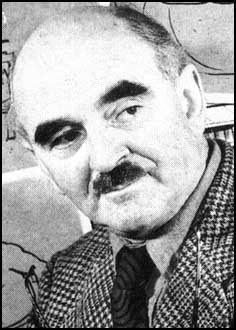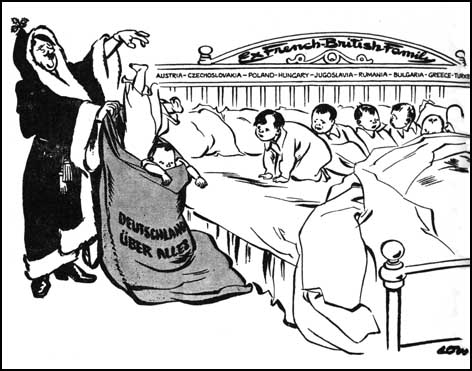David Low - A mini-biography
 David Low was born in Dunedin, New Zealand in 1891. His father's family
had originally come from Fifeshire in Scotland. As a young man he had
discovered a pile of old copies of Punch Magazine in a second-hand bookshop
in Christchurch. Deeply impressed by the work of Charles Keene, Linley
Sambourne and Phil May, Low decided he wanted to become a cartoonist.
David Low was born in Dunedin, New Zealand in 1891. His father's family
had originally come from Fifeshire in Scotland. As a young man he had
discovered a pile of old copies of Punch Magazine in a second-hand bookshop
in Christchurch. Deeply impressed by the work of Charles Keene, Linley
Sambourne and Phil May, Low decided he wanted to become a cartoonist.
At the age of fifteen Low began to have his drawings published in magazines
and newspapers in New Zealand. This included anti-gambling cartoons for
the War Cry, the newspaper of the Salvation Army, and illustrations for
New Zealand Truth, a weekly newspaper specializing in sensational crime
and sex . Still a teenager, Low was appointed the regular political cartoonist
of the New Zealand Spectator. His fame spread to Australia and at the age
of eighteen he was asked to join the Sydney Bulletin, where he worked with
two other great cartoonists, Livingstone Hopkins and Norman Lindsay.
[P&P note: Norman Lindsay wrote the book that Age of Consent
(1968) was made from]
The British writer Arnold Bennett was impressed when he saw Low's cartoons
and wrote an article about him in the New Statesman. This resulted in Low
being offered a job in England with The Daily News and the company's evening
paper, the Star. Low arrived in England in 1919 but was unhappy with the
space that he was given for his cartoons. After threatening to resign, the
editor of the Star agreed to publish the large, half-page cartoons that
he had been doing in Australia. In London Low became a close friend of the
other great political cartoonist of the period, Will Dyson of the Daily
Herald.
Low was commissioned by the Star to draw the portraits of the fifty most
distinguished people in Britain. His subjects included George Bernard Shaw,
Arnold Bennett, H. G. Wells, Hilaire Belloc, G. K. Chesterton and Arthur
Conan Doyle. Only two men refused to sit for him: John Galsworthy and Rudyard
Kipling.
After a disagreement with the editor about how this should be presented
in the Star, Low eventually had them published in the New Statesmen. Low
also had cartoons published in other journals in Britain such as Punch Magazine
and The Graphic.
In 1927 Low was persuaded by Lord Beaverbrook to work at the Evening Standard.
Although Beaverbrook was a strong supporter of the Conservative Party, he
promised Low that he would have complete freedom to express his own radical
political views.
Unhappy with the political leadership of the British establishment David
Low created his cartoon character, Colonel Blimp in 1934. In his autobiography,
Low explained that Blimp represented everything he disliked in British politics:
"Blimp was no enthusiast for democracy. He was impatient with the common
people and their complaints. His remedy to social unrest was less education,
so that people could not read about slumps. An extreme isolationist, disliking
foreigners (which included Jews, Irish, Scots, Welsh, and people from the
Colonies and Dominions); a man of violence, approving war. He had no use
for the League of Nations nor for international efforts to prevent wars.
In particular he objected to any economic reorganization of world resources
involving changes in the status quo."
In the 1930s Low joined with other radicals, such as Stafford Cripps, Nye
Bevan, Ellen Wilkinson, J. B. Priestley, Victor Gollancz, Henry Nevinson
and Norman Angell to complain about Britain's foreign policy. Low was especially
appalled by what he called the "Government's supine attitude to foreign
intervention in Spain" during the Spanish Civil War.
Low's cartoons criticizing Hitler and Mussolini resulted in his work being
banned in Germany and Italy. After the war it was revealled that in 1937
the German government asked the British government to have "discussions
with the notorious Low" in an effort to "bring influence to bear on him"
to stop his cartoons attacking appeasement.
Low was attacked in the press as a "war-monger". However, others welcomed
his criticisms of Hitler. This included Sigmund Freud who wrote: "A Jewish
refugee from Vienna, a very old man personally unknown to you, cannot resist
the impulse to tell you how much he admires your glorious art and your inexorable,
unfailing criticism."
In the Second World War Low's cartoons such as All Behind You, Winston (14th
May, 1940), Stay There! I'll Be Back (24th May, 1940) and Very Well, Alone
(18th June, 1940) were used to inspire the British people at a time when
many feared a German victory.
Low left the Evening Standard in 1949 and later worked for the Daily Herald
(1950-1953) and the Manchester Guardian (1953-1963).
Published collections of Low's work include: A Cartoon History of the War
(1941), Low's Company (1952), Low's Autobiography (1956) and Years of Wrath:
1932-1945 (1986). David Low, who was knighted in 1962, died in 1963.

David Low, Evening Standard (10th October, 1938)


 David Low was born in Dunedin, New Zealand in 1891. His father's family
had originally come from Fifeshire in Scotland. As a young man he had
discovered a pile of old copies of Punch Magazine in a second-hand bookshop
in Christchurch. Deeply impressed by the work of Charles Keene, Linley
Sambourne and Phil May, Low decided he wanted to become a cartoonist.
David Low was born in Dunedin, New Zealand in 1891. His father's family
had originally come from Fifeshire in Scotland. As a young man he had
discovered a pile of old copies of Punch Magazine in a second-hand bookshop
in Christchurch. Deeply impressed by the work of Charles Keene, Linley
Sambourne and Phil May, Low decided he wanted to become a cartoonist.
